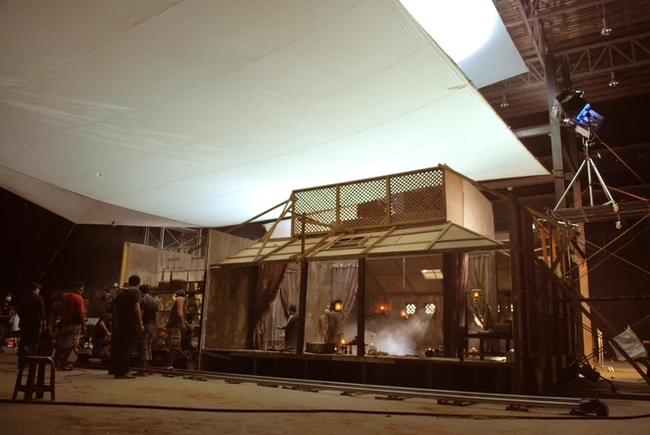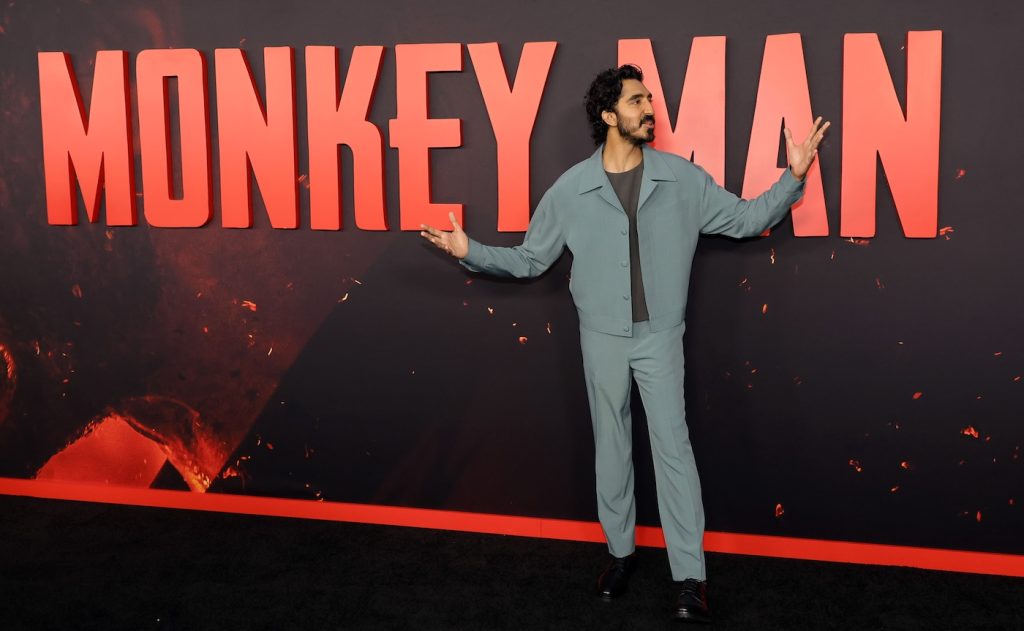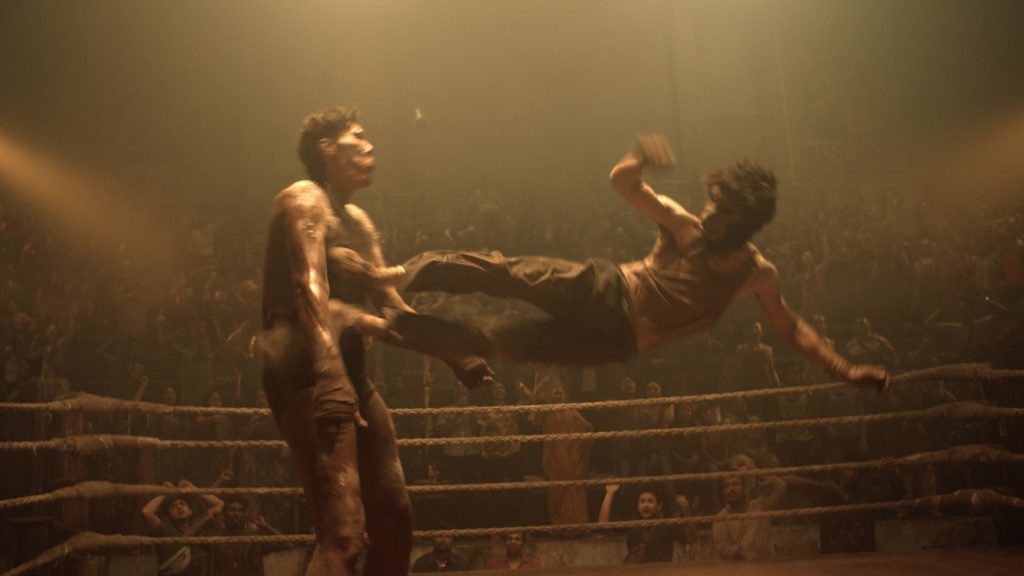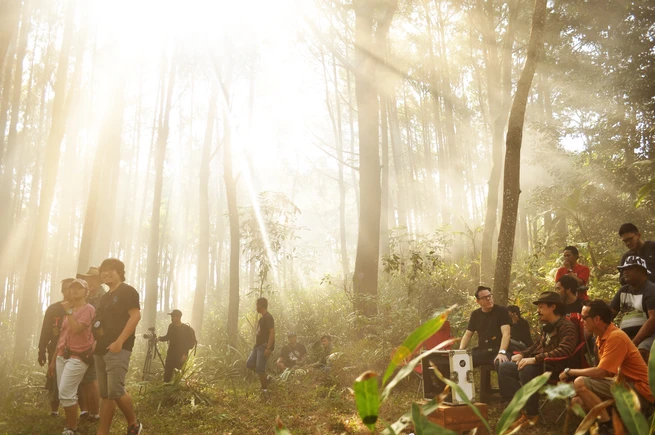From Mumbai to Batam: The Unexpected Journey of Dev Patel’s “Monkey Man”
Actor-turned-director Dev Patel, best known for his breakthrough role in Slumdog Millionaire, received a well-earned standing ovation for his directorial feature debut, Monkey Man, at the SXSW Film & TV Festival in Austin Texas this past March. His thrilling, kinetic debut went on to win the Headliners Audience Award.
The fight-filled action epic produced by Get Out and Us director Jordan Peele was inspired by the story of the half-monkey, half-human Hindu god Hanuman. Patel stars as the Kid, an anonymous young man nursing a wound so elemental it becomes a source of inexhaustible rage and, ultimately, power. Set in Mumbai, the plot revolves around the bone-shattering revenge journey as The Kid dons a gorilla mask and sets out to avenge his mother’s murder. Following its world premiere at SXSW, Monkey Man was released in the United States by Universal in April.
Monkey Man was meant to film in Mumbai, where it was set; however, the outbreak of the COVID-19 pandemic derailed those production plans. Like the Kid, the cast and crew of Monkey Man needed to find a new way toward their goal.
The production ended up in Batam, an island in Indonesia that is a short ferry ride from Singapore and home to one of the largest production and animation facilities in Southeast Asia, operated by Infinite Studios.
Infinite Studios has been a busy fount of creative action. In the past decade, its Batam facilities’ productions have included the HBO Asia series Grisse, Folklore, Dead Mine, Halfworlds, and Serangoon Road. Since Monkey Man was shot there, Batam has recently hosted more original series productions: Operandi Gerhana for Singapore’s MediaCorp and Losmen Melati, produced by Infinite Studios and Taiwan’s Catchplay. Later this year, the studio will release the feature film Orang Ikan, which is set to premiere at the gala section of the upcoming Tokyo International Film Festival (October 28-November 6).

We spoke to Mike Wiluan, CEO of Infinite Studios, about how the production overcame the many challenges of shooting during COVID-19 on the island of Batam and got Patel’s scorching debut into theaters.
From India to Indonesia, how did Monkey Man end up on Batam Island?
I’ve known Dev Patel for some years. He was a frequent guest at the Singapore International Film Festival (SGIFF) when I was the festival chairman. Unfortunately, Monkey Man was in preparation in Mumbai when COVID-19 hit, and the production had to be shut down. Dev and his team called me and enquired whether they could move the production to Batam. We had just completed a show and had space for them.

That was at the peak of the pandemic. What made Patel think Batam was the right place?
As Covid was spreading and countries shutting down with strict controls, we had to immediately present the opportunity to relevant government agencies in Indonesia to prepare a safe and plausible way to continue production. Batam and the studio in Nongsa were very isolated, including the resorts that would be entirely dedicated to the show; the authorities were confident that the project could be managed. The entirety of the production was produced in our studios in Nongsa and some remote locations in Batam. There were some plates and drone shots done in Batam.
How did the pre-production and production come together once Batam was confirmed as the alternative filming location?
Once we had government approvals, we contacted the Indonesian Embassies around the world to facilitate visas for the heads of departments and actors. Dev and his team were the first into Batam and began their 14-day quarantine immediately. As designs were finalized, the sets, both interiors and exteriors, soon started to be built on the backlot. It took around three months of preparation before shooting commenced. The time was extended as strict COVID protocols were adhered to. From pre-production to production, the shoot took around six months.

What kind of filming support did Infinite Studios provide?
Infinite Studios provided studio facilities, government permissions, production administration, casting, logistics, catering, camera and technical equipment, building, and the provision of local film crews.
Batam served to double up as Mumbai, which is a very distinct, bustling city. What kind of sets need to be built?
The two soundstages (30 sq ft and 14 sq ft) acted as interior spaces, and many interiors were built. The backlot (one hectare) was used as Mumbai’s modern city, so the facades were decorated in Mumbai fashion, including props. There were some mock-up sets on our empty land and forest areas that doubled as village sets. Other locations we filmed included an abandoned hotel, which had a ballroom, full-size service kitchen, and lifts. Some more derelict areas of Batam were used.
How did you manage crowd scenes with many extras while adhering to strict COVID protocols??
We carefully ensured that different types of extras went through quarantine and testing procedures. Day background extras were separated into different areas, and the assistant directors carefully ensured they were shot in efficient groups.
You mentioned the HODs were from overseas. What was the ratio of overseas and local crew?
We had HODs from overseas, such as cinematographers, action choreographers, production designers, and wardrobe. Several key HODs from India brought cultural relevance, especially in wardrobe. Most of the crew (90%) were from Indonesia and supported all departments.
Productions worldwide are now available online to viewers everywhere. You are also a filmmaker, having directed both films (Buffalo Boys, upcoming Orang Ikan) and series (Operandi Gerhana, Losmen Melati). What are your thoughts on copyright?
We are finding that more often when we release content on streaming platforms, it is quickly uploaded onto social media. TikTok has been a frequent platform for snack-sized content, which is then uploaded multiple times to form an episode. For a country like Indonesia, which thrives on social media, we have found a huge viewership from watching bite-sized content on social media platforms. The shows have become very viral, and viewership numbers are significant.

Is there anything you can do?
Some platforms take action to bring the content down, but it is an endless task as they quickly appear elsewhere. Some platforms may see this viral spread as a positive view on promotion and a potential boost to their subscriber base. However, as producers, much effort has been spent crafting the show to be seen as intended, and it quickly appears elsewhere, so seeing this effort being cut into bite-sized chunks can be frustrating.
Indonesia seems to be slow to make any production incentives available. Has it made any progress lately?
Government incentives greatly increase our competitive edge as a production house and studio with significant infrastructure investment in Indonesia. The discussion on incentives has been a long road that has been championed not only by us but by the entire industry, which is looking to produce better-quality films for a growing domestic market with the potential for overseas distribution.
How’s the progress been so far?
Despite much effort in lobbying government ministries and agencies, many of these discussions are heard but, sadly, not acted upon. More recently, there have been efforts to announce some programs based on a matching fund scheme, but even then, the process has been rather vague. The long and toothless argument of Indonesia being a ‘cheap’, ‘value added’ or ‘location diverse’ destination is not something we want to boast about. We have deep talent and a committed, skilled workforce who have evolved tremendously in leaps and bounds over the years, with thanks to the box office growth and original productions from streamers.
What are the real roadblocks here?
Much of the footdragging comes from the fact that administrators do not understand the nature of the industry and how the industry provides an economic domino effect across other business ecosystems. Not to mention the benefits of fostering growth and potential of the country’s fledgling creative sector, but also the positive public relations image for Indonesia globally – in particular to its tourism industry, which still remains a key strategic growth sector today. However, as box office numbers continue to grow and more Indonesian filmmakers are making headlines in festivals and working overseas – the government is taking notice and giving support. However, the support is more of a blessing than actual defined incentives.
What kind of action should be taken that will benefit the industry?
Choosing the right path for transparently and fairly administering incentives still needs further robust study. The other complicated issue is that these incentives (if acted on now) would need to involve several ministries, including the Ministry of Finance. But with the elections completed and a new cabinet being formed, we are waiting to see if there will be dedicated and clear administrators who will handle this matter moving forward. We are hopeful, given that several international productions have brought wide praise for our talented filmmakers. However, the loudest voices have come from the public, who are incredibly proud of the achievements made so far. The government has taken notice, and with the new cabinet soon to be in place, we hope the road ahead will lead to a final destination that will benefit the industry as a whole.
For more interviews with filmmakers and producers taking big swings in Asia, check these out:
Benetone Films Co-Founder Kulthep Narula on Taking Thailand’s Film Industry to the Next Level
Pioneering Producer Auchara Kijkanjanas on Animating Thailand’s Entertainment Industry
Reimagining Korea’s Dynamic Film & TV Industry With Wow Point Executive Producer Yoomin Hailey Yang
Featured image: Dev Patel in Monkey Man. Courtesy Universal Pictures.



